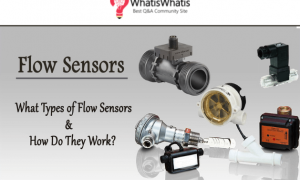A flow sensor is a device designed for measuring the flow rate of liquid or gases flowing through a conduit or pipe. Many industrial processes need effective control to ensure the machinery operates at optimum levels and with efficiency.
Even automobiles use a flow sensor to measure the amount of air intake by the engine. Besides, a sensor helps adjust the fuel delivery to fuel injectors to attain the desired fuel mixture in the engine.
Flow sensor types and how they work
1. Positive displacement flow sensors
Positive displacement is a unique sensor since you can use it to measure the flow rate of fluid that passes through the device directly. Other flow sensor types use different parameters and apply the data obtained to infer the flow rate.
The Positive displacement sensor entraps and moves the fluid through the sensor using rotating parts. The fluid being moved is of known volume. When the rotating part makes a full revolution, it passes a known fluid volume through the sensor.
Know more: How Liquid flow sensor Works Accurate in Flow Measurement?
So, if you count the number of rotations occurring per unit time, you get the volume of fluid per unit time. As the fluid flows through the sensor, it forces the rotational components to move. That’s why the rotational velocity is proportional to the fluid flow rate.
The mechanical seals in the positive displacement flow sensor help to trap the fluid within the sensor. They are designed in a way that prevents the fluid from passing through the device without being measured. And that’s why you can rely on a positive displacement sensor for accurate flow measurement.
You can use a positive displacement sensor to determine the flow rate of fluid with different viscosities. But that’s not the only benefit you’ll enjoy when using this sensor. The device requires low maintenance and offers an electronic or mechanical interface.
A positive displacement sensor is suitable for a wide range of applications. You can apply it for hydraulic fluid monitoring, gasoline, and oils. Even at home, you may install a PD sensor for metering water and gas.
2. Velocity flow sensors
These flow sensor types determine fluid flow rate by using a sensor to measure fluid’s velocity. Many velocity sensors exist in the market and include ultrasonic, electromagnetic, and mechanical.
A mechanical sensor, like a paddle wheel, is mounted with mobile parts that sit in the flow path and rotate when the fluid passes through the device. Then, a sensor like infrared, magnetic coil, and Hall Effect detects the rotation.
The electronics of the flow sensor will then convert the rotation into the output signal. The signal may cause a rectangular wave pulse, and the device programs such a signal to represent specific volume output per unit time.
A paddlePaddlewheel sensor is a device to buy if you want a cost-effective device. The sensor is compact and needs little energy to function. Another benefit you will enjoy by choosing a paddle sensor is that it can work with an array of fluid types.
The paddlewheel flow meter isn’t perfect either. The moving parts make it wear easily, which increases the cost of maintenance. The buildup of sediments and other solid materials also affects the flow sensor work.
Learn more: What is a Water Flow Detector, and How it Works?
The electronic sensor has a coil used for inducing a magnetic field in the fluid being monitored. Once that occurs, the device uses electrodes for measuring the induced voltage. The voltage produced is proportional to the velocity of the flowing fluid. After getting the velocity and cross-section of your pipe, you can convert its volumetric flow rate.
3. Mass flow sensors
These are sensors that help determine flow rate by measuring energy transfer from a heated surface to the flowing fluid. You may use approaches to measure flow rate using mass sensors.
In one approach, you introduce a specific amount of thermal energy and measure the temperature change. The other approach requires you to maintain the probe at a constant temperature and then measure the amount of energy used to do that.
The hot wire mass sensor uses an electric current introduced to a resistant wire with equal temperature to the flow sensor. When the air flowing through the sensor rises, the conductive heat transfer leads to a temperature drop in the wire. That reduces electrical resistance.
As the resistance reduces, there will be an increase in current drawn which allows measurement of electrical current required for maintaining hot wire temperatures. The results indicate the mass flow rate of the air.
Coriolis sensor is another style of mass flow sensor. The sensor works based on the idea that fluid flows in an oscillating tube exhibits inertia and makes the tube twist. The degree to which the tube twists helps to determine the mass flow rate.
Read more: Why Is Dew Point Important for Flow sensors?
Factors to consider when buying a flow sensor
- Type of medium you seek to monitor
- Acceptable pressure loss
- Range of flow required
- Output signal requirement
- Levels of accuracy are needed.
- Source of power.
Conclusion
Many suppliers have got different types of flow sensors. Though a flow sensor works differently, you can always rely on them for accurate flow rate measurement. But ensure to inquire how every sensor works before section any.






Leave a comment